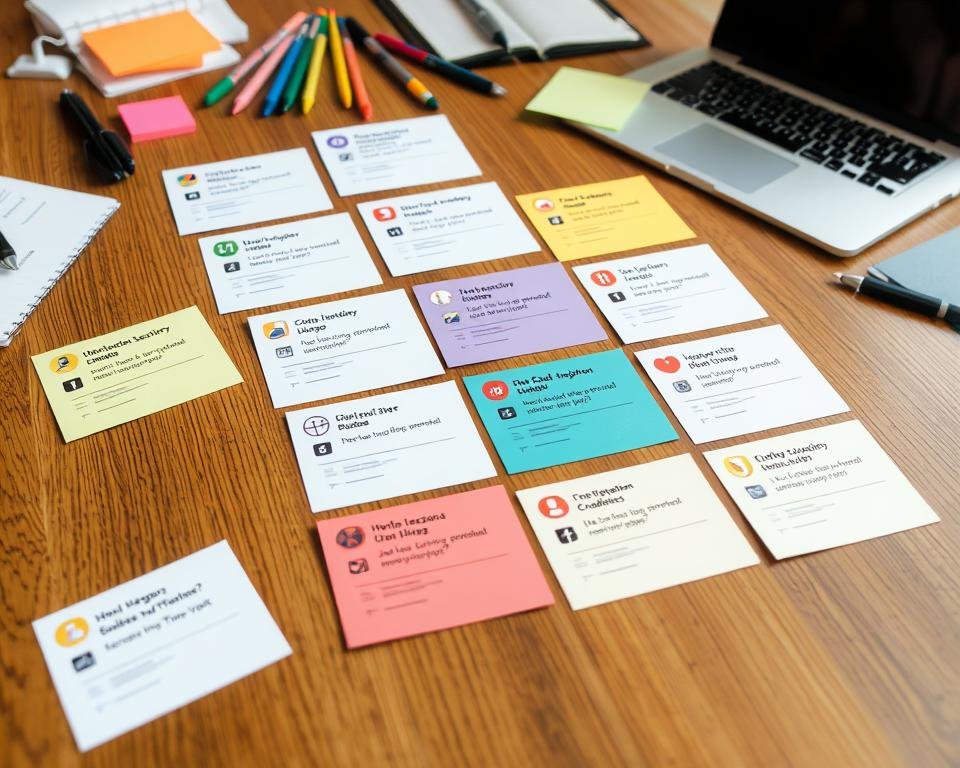When you’re doing surveys, it’s key to ask about people’s jobs. This info gives us a peek into the job world. It helps us understand what people do, what they want to do, and their work experiences.
By asking the right job questions, you can get useful data. This data helps with work analysis, career planning, and spotting job market trends.
It’s smart to ask about current and desired job titles. Also, asking about career changes in the last year is helpful. Questions about specific job roles, like management or quality assurance, can give deeper insights.
These questions help you understand people’s jobs, what they want, and their career goals. This info is super useful for planning work strategies, finding skill gaps, and improving talent programs.
The content discusses the importanceof saying no to a job interview nicely. Asking about job positions in your survey can give you the best insights. This helps you make smart choices and improve the work environment.
Understanding the Importance of Job Position Questions in Surveys
Asking about job positions in surveys is key for understanding the workforce. It helps businesses see how employees move between roles. This is important because it affects how well they do their jobs.
Knowing about job roles helps companies make smart hiring choices. It also helps find the right people for different jobs in the company.
Impact on Workforce Analytics
Survey data on job roles gives insights for workforce analytics. It shows how employees move, where skills are lacking, and guides decisions on hiring, training, and planning for the future.
Benefits of Accurate Job Role Data
Accurate job role data from surveys has many benefits for businesses:
- It helps plan the workforce and manage talent better.
- It finds top performers and their chances for moving up.
- It makes sure employees have the right skills for their jobs.
- It helps create training programs that target specific needs.
- It improves the company’s response to changes in workplace queries and job descriptions.
“Asking the right questions about job positions in surveys can provide invaluable insights into an organization’s career roles and workforce dynamics.”
Understanding the value of job position questions helps businesses use survey data wisely. It aids in making better decisions, improving workplace queries, and driving strategic workforce plans.

Essential Components of Job Position Survey Questions
Job position survey questions are key to understanding your workforce. They help uncover career goals, job satisfaction, and retention risks. Here are the must-haves for these questions:
- Current Job Title: Knowing an employee’s current job title helps you see your team’s structure. It also shows if there are any job title issues.
- Desired Job Title: Asking about their dream job shows their career ambitions. This helps you plan for their growth and training needs.
- Reasons for Wanting to Leave: Finding out why someone might leave gives insight into job happiness and work-life balance. It also points out areas to improve to keep them.
It’s also important to ask about short-term and long-term career goals. Knowing where they want to be in 3-5 years helps align your company’s growth with their dreams.
“Selecting thorough parameters for an employee satisfaction survey includes job, supervisors, peers, growth, benefits, pay, and leadership.”
By asking these key questions, you can better understand your team. You can spot areas to improve and create plans to keep your team happy and engaged.
Tailoring Survey Questions to Gather Meaningful Insights
When making your survey questions, make them clear and to the point. Avoid confusing words or jargon. Focus on getting feedback that can help improve your job positions and team strategies.
How to Ask a Current Job Position in Survey: Best Practices
When making survey questions about a person’s current job, it’s key to be clear. Use simple words and avoid confusing terms. Offer different ways to answer, like choosing from a list or writing in a specific job title.
Clear Terminology and Language
Make sure your survey questions are easy to get. Use words everyone knows. Stay away from technical terms that not everyone understands.
Response Format Options
- Multiple-choice options for broad job role categories (e.g., manager, supervisor, entry-level, etc.)
- Open-ended text fields for participants to enter their specific job title
- Dropdown menus with a complete list of job titles
Avoiding Common Pitfalls
Watch out for questions that might lead someone to answer in a certain way. Keep your questions fair and don’t assume anything about their job. Mix up your questions to get a full picture of their job and future plans.
“Asking the right questions about a respondent’s current job position is key for getting good data in your survey.”

By following these tips, you can make survey questions that really get at what someone does now. This will help you get the insights you need for your research or business goals.
Structuring Career Transition Questions
Understanding your survey respondents’ career paths is key. Asking the right questions about their job changes can offer deep insights. By exploring their past roles, reasons for job changes, and future goals, you can learn a lot about their career roles and what they want to do next.
Begin by asking about their past jobs. Questions like “What was your previous job?” and “Why did you switch careers?” can reveal patterns. They help you see what drives their career choices.
Then, ask about their future plans. Questions like “Have you thought about changing jobs in the last year?” and “What jobs are you considering?” can show emerging trends. This helps spot skills that might be needed in the future.

By focusing on career transitions in your survey, you can really understand your respondents’ professional paths. This data is gold for improving your workforce, helping careers grow, and making smart business decisions.
Collecting Meaningful Job Role Information
Understanding your employees’ job roles and career paths is key for better workforce planning. By looking into their current jobs, career growth, and work history, you can find important insights. These insights help guide your organization’s decisions.
Current Position Details
Begin by gathering details about your employees’ current jobs and how long they’ve been in them. This info shows their daily tasks, skills, and how their roles have changed. Ask about their job’s scope, tasks, and how long they’ve been in their current role.
Career Progression Insights
Learn about your employees’ career growth by asking about promotions, job title changes, or skill improvements. Knowing their career growth helps spot chances for more growth and skill development in your company.
Professional Background Context
To fully understand your employees’ careers, ask about their work history, including past industries and roles. This background helps see how their past experiences match their current and future goals. It also guides your job descriptions and workplace queries.
“Collecting detailed information about job roles and career progression allows organizations to make informed decisions that support employee growth and align with business objectives.”
By asking the right questions and gathering meaningful job role info, you unlock valuable insights. These insights improve your workforce analytics, inform job descriptions, and help your organization grow strategically.
Incorporating Salary and Job Satisfaction Elements
When making a detailed survey, it’s key to look into who’s answering and what they do. You should ask about their current and future earnings to see what they hope to make. Also, finding out how happy they are at work can tell you a lot about keeping them around.
To check job happiness, ask people to rate their joy from 1 to 10. Scores under 6 or 7 might show they’re not happy. Also, ask what they liked most about their job and what they learned from their best boss. This helps understand what makes people happy at work.
“Satisfied employees are 31% more productive. PARI GmbH achieved an impressive 80% survey participation rate by combining Honestly’s templates with custom questions.”
Adding salary and job happiness questions to your survey can give you lots of useful info. This data can help you understand your team better and make choices to keep them happy and productive. By focusing on these key areas, you can make your survey more useful and meaningful for everyone involved.
- Assess current and expected pay ranges to understand salary expectations
- Evaluate job satisfaction levels by asking respondents to rate their happiness on a scale
- Inquire about the best aspects of their current or previous job and what their favorite employer taught them
- Leverage the insights to inform workforce analytics and improve employee retention and satisfaction
Conclusion
Making good job position survey questions is key. It helps gather data for better hiring, planning, and understanding career paths. Clear questions, right answers, and fair questions are important. This way, companies get useful info on current jobs, future plans, salary hopes, and job happiness.
Survey results help find the right candidates, move people within the company, and match training with goals. Adding salary and job satisfaction info gives a full picture of work life. This leads to better keeping and happier employees.
In today’s changing work world, surveys are a big help. They guide important decisions and improve work life. By following best practices and improving surveys, companies can reach their full workforce power. This leads to lasting success.